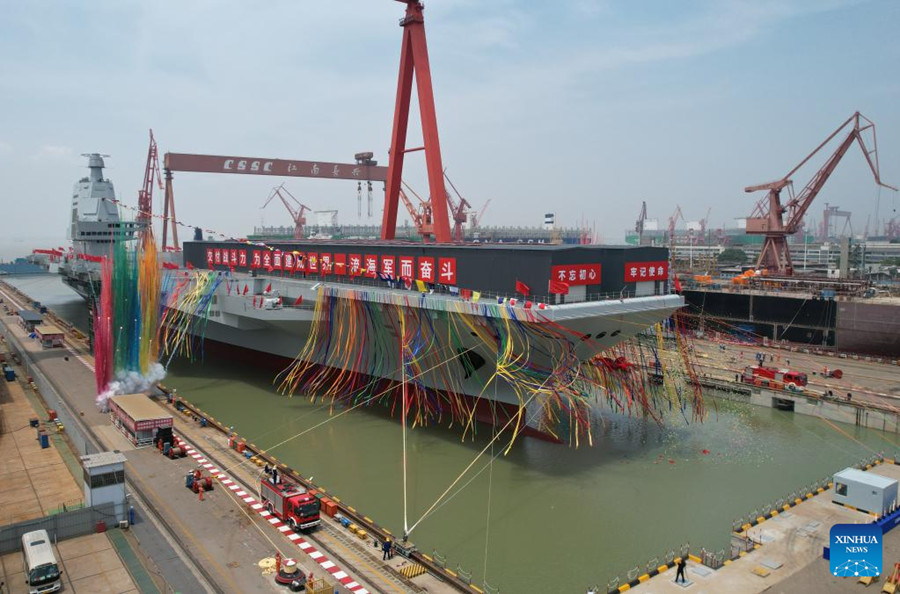
Photo taken on June 17, 2022 shows the launching ceremony of China's third aircraft carrier, the Fujian, in East China's Shanghai. The carrier, named after Fujian province, was completely designed and built by the country. [Photo/Xinhua]
This is an editorial from China Daily.
It may have created less hoopla at home and abroad than that of its two predecessors, yet the launch of the Fujian aircraft carrier on Friday is a landmark in the modernization of the People's Liberation Army Navy.
The first domestically built aircraft carrier with an electromagnetic catapult system to launch aircraft and the third such vessel of the PLA Navy — after the Liaoning and Shandong — shows the country now has the expertise to independently design and build advanced, conventionally powered aircraft carriers.
The Fujian is equipped with blocking devices and has a full load displacement of more than 80,000 tons. That the Fujian was built at the Jiangnan Shipyard in Shanghai and both the Liaoning and Shandong were built at the Dalian Shipyard in Liaoning province shows China's two largest shipyards now have the capability to build aircraft carriers.
In the 10 years since the commissioning of the Liaoning in 2012 — it was built from the hull of the half-built Admiral Kuznetsov-class Varyag aircraft carrier of the Soviet Union — China has mastered the art of designing and building aircraft carriers thanks to its comprehensive industrial design and manufacturing system.
With the Liaoning as a base for training shipboard aircraft crew, the commissioning of the Shandong in 2019 — the first domestically built aircraft carrier modeled on the Liaoning that uses ski-jump launching system which limits the size and number of planes that can take off from a slight ramp — helped the PLA Navy gather valuable first-hand experience in cooperative combat of an aircraft strike group.
With the Liaoning and Shandong being increasingly used for patrolling and drills, China needed another aircraft carrier to increase its deterrence capacity, in order to maintain maritime peace and stability in the region. The Fujian can do that job once it completes its sea trials and is commissioned. In fact, China needs at least three aircraft carriers to protect its shores, maritime territories and strategic interests.
Yet the fact that the PLA Navy has become the largest navy in the world in terms of vessel displacement capacity — which is different from actual combat capacity — does not mean China has changed its defense policy which is purely defensive in nature. The focus of the PLA Navy is not to become bigger but stronger so that it can meet the requirements of the country, and defend its core development interests, as well as sovereignty and territorial integrity.
Since China, despite becoming a big maritime power, remains committed to defending world peace and fulfilling its international responsibilities including undertaking rescue and relief operations during natural disasters and other emergencies, providing humanitarian aid and maintaining security in the seas, the modernization of its navy will go a long way in safeguarding the common interests of all peace-loving nations.

 中文
中文



